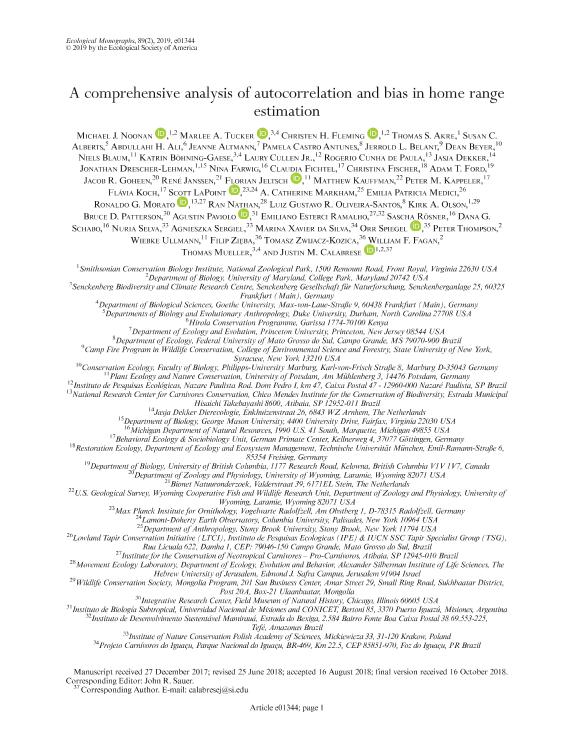Artículo
A comprehensive analysis of autocorrelation and bias in home range estimation
Noonan, Michael J.; Tucker, Marlee A.; Fleming, Christen H.; Akre, Thomas S.; Alberts, Susan C.; Ali, Abdullahi H.; Altmann, Jeanne; Antunes, Pamela Castro; Belant, Jerrold L.; Beyer, Dean; Blaum, Niels; Böhning Gaese, Katrin; Cullen Jr., Laury; de Paula, Rogerio Cunha; Dekker, Jasja; Drescher Lehman, Jonathan; Farwig, Nina; Fichtel, Claudia; Fischer, Christina; Ford, Adam T.; Goheen, Jacob R.; Janssen, René; Jeltsch, Florian; Kauffman, Matthew; Kappeler, Peter M.; Koch, Flávia; LaPoint, Scott; Markham, A. Catherine; Medici, Emilia Patricia; Morato, Ronaldo G.; Nathan, Ran; Oliveira Santos, Luiz Gustavo R.; Olson, Kirk A.; Patterson, Bruce; Paviolo, Agustin Javier ; Ramalho, Emiliano Esterci; Rösner, Sascha; Schabo, Dana G.; Selva, Nuria; Sergiel, Agnieszka; Xavier da Silva, Marina; Spiegel, Orr; Thompson, Peter; Ullmann, Wiebke; Ziḝba, Filip; Zwijacz Kozica, Tomasz; Fagan, William F.; Mueller, Thomas; Calabrese, Justin M.
; Ramalho, Emiliano Esterci; Rösner, Sascha; Schabo, Dana G.; Selva, Nuria; Sergiel, Agnieszka; Xavier da Silva, Marina; Spiegel, Orr; Thompson, Peter; Ullmann, Wiebke; Ziḝba, Filip; Zwijacz Kozica, Tomasz; Fagan, William F.; Mueller, Thomas; Calabrese, Justin M.
 ; Ramalho, Emiliano Esterci; Rösner, Sascha; Schabo, Dana G.; Selva, Nuria; Sergiel, Agnieszka; Xavier da Silva, Marina; Spiegel, Orr; Thompson, Peter; Ullmann, Wiebke; Ziḝba, Filip; Zwijacz Kozica, Tomasz; Fagan, William F.; Mueller, Thomas; Calabrese, Justin M.
; Ramalho, Emiliano Esterci; Rösner, Sascha; Schabo, Dana G.; Selva, Nuria; Sergiel, Agnieszka; Xavier da Silva, Marina; Spiegel, Orr; Thompson, Peter; Ullmann, Wiebke; Ziḝba, Filip; Zwijacz Kozica, Tomasz; Fagan, William F.; Mueller, Thomas; Calabrese, Justin M.
Fecha de publicación:
11/2018
Editorial:
Ecological Society of America
Revista:
Ecological Monographs
ISSN:
0012-9615
Idioma:
Inglés
Tipo de recurso:
Artículo publicado
Clasificación temática:
Resumen
Home range estimation is routine practice in ecological research. While advances in animal tracking technology have increased our capacity to collect data to support home range analysis, these same advances have also resulted in increasingly autocorrelated data. Consequently, the question of which home range estimator to use on modern, highly autocorrelated tracking data remains open. This question is particularly relevant given that most estimators assume independently sampled data. Here, we provide a comprehensive evaluation of the effects of autocorrelation on home range estimation. We base our study on an extensive data set of GPS locations from 369 individuals representing 27 species distributed across five continents. We first assemble a broad array of home range estimators, including Kernel Density Estimation (KDE) with four bandwidth optimizers (Gaussian reference function, autocorrelated-Gaussian reference function [AKDE], Silverman´s rule of thumb, and least squares cross-validation), Minimum Convex Polygon, and Local Convex Hull methods. Notably, all of these estimators except AKDE assume independent and identically distributed (IID) data. We then employ half-sample cross-validation to objectively quantify estimator performance, and the recently introduced effective sample size for home range area estimation ((Formula presented.)) to quantify the information content of each data set. We found that AKDE 95% area estimates were larger than conventional IID-based estimates by a mean factor of 2. The median number of cross-validated locations included in the hold-out sets by AKDE 95% (or 50%) estimates was 95.3% (or 50.1%), confirming the larger AKDE ranges were appropriately selective at the specified quantile. Conversely, conventional estimates exhibited negative bias that increased with decreasing (Formula presented.). To contextualize our empirical results, we performed a detailed simulation study to tease apart how sampling frequency, sampling duration, and the focal animal´s movement conspire to affect range estimates. Paralleling our empirical results, the simulation study demonstrated that AKDE was generally more accurate than conventional methods, particularly for small (Formula presented.). While 72% of the 369 empirical data sets had >1,000 total observations, only 4% had an (Formula presented.) >1,000, where 30% had an (Formula presented.) <30. In this frequently encountered scenario of small (Formula presented.), AKDE was the only estimator capable of producing an accurate home range estimate on autocorrelated data.
Archivos asociados
Licencia
Identificadores
Colecciones
Articulos(IBS)
Articulos de INSTITUTO DE BIOLOGIA SUBTROPICAL
Articulos de INSTITUTO DE BIOLOGIA SUBTROPICAL
Citación
Noonan, Michael J.; Tucker, Marlee A.; Fleming, Christen H.; Akre, Thomas S.; Alberts, Susan C.; et al.; A comprehensive analysis of autocorrelation and bias in home range estimation; Ecological Society of America; Ecological Monographs; 89; 2; 11-2018
Compartir
Altmétricas



